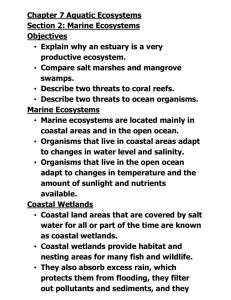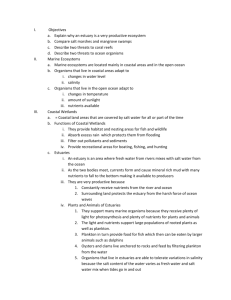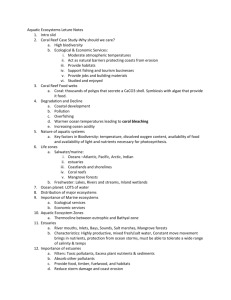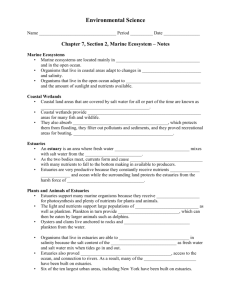Ecology Name - Plain Local Schools
advertisement
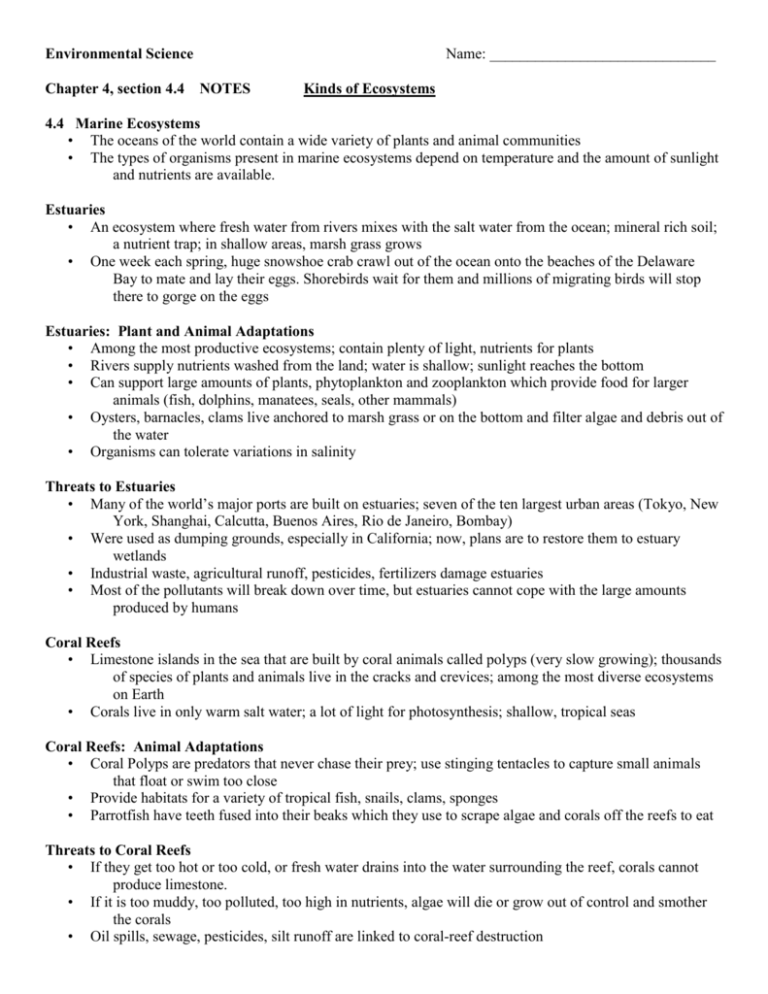
Environmental Science Chapter 4, section 4.4 Name: ______________________________ NOTES Kinds of Ecosystems 4.4 Marine Ecosystems • The oceans of the world contain a wide variety of plants and animal communities • The types of organisms present in marine ecosystems depend on temperature and the amount of sunlight and nutrients are available. Estuaries • An ecosystem where fresh water from rivers mixes with the salt water from the ocean; mineral rich soil; a nutrient trap; in shallow areas, marsh grass grows • One week each spring, huge snowshoe crab crawl out of the ocean onto the beaches of the Delaware Bay to mate and lay their eggs. Shorebirds wait for them and millions of migrating birds will stop there to gorge on the eggs Estuaries: Plant and Animal Adaptations • Among the most productive ecosystems; contain plenty of light, nutrients for plants • Rivers supply nutrients washed from the land; water is shallow; sunlight reaches the bottom • Can support large amounts of plants, phytoplankton and zooplankton which provide food for larger animals (fish, dolphins, manatees, seals, other mammals) • Oysters, barnacles, clams live anchored to marsh grass or on the bottom and filter algae and debris out of the water • Organisms can tolerate variations in salinity Threats to Estuaries • Many of the world’s major ports are built on estuaries; seven of the ten largest urban areas (Tokyo, New York, Shanghai, Calcutta, Buenos Aires, Rio de Janeiro, Bombay) • Were used as dumping grounds, especially in California; now, plans are to restore them to estuary wetlands • Industrial waste, agricultural runoff, pesticides, fertilizers damage estuaries • Most of the pollutants will break down over time, but estuaries cannot cope with the large amounts produced by humans Coral Reefs • Limestone islands in the sea that are built by coral animals called polyps (very slow growing); thousands of species of plants and animals live in the cracks and crevices; among the most diverse ecosystems on Earth • Corals live in only warm salt water; a lot of light for photosynthesis; shallow, tropical seas Coral Reefs: Animal Adaptations • Coral Polyps are predators that never chase their prey; use stinging tentacles to capture small animals that float or swim too close • Provide habitats for a variety of tropical fish, snails, clams, sponges • Parrotfish have teeth fused into their beaks which they use to scrape algae and corals off the reefs to eat Threats to Coral Reefs • If they get too hot or too cold, or fresh water drains into the water surrounding the reef, corals cannot produce limestone. • If it is too muddy, too polluted, too high in nutrients, algae will die or grow out of control and smother the corals • Oil spills, sewage, pesticides, silt runoff are linked to coral-reef destruction • • Overfishing can devastate fish populations, upsetting the balance Reef cannot repair itself after being destroyed by careless divers, shipwrecks, anchors, people breaking off pieces The Ocean • Covers nearly ¾ of Earth’s surface • Plants only grow where there are nutrients and light; most life is in shallow water around the edges of continents; abundant with plants and animals in these areas • Open ocean, phytoplankton grows near the surface (sunlight) if there are nutrients; one of the least productive of all ecosystems • The depths of the ocean are dark and most of the food consists of dead Ocean: Plant Adaptations • No flowering plants except around the edges • Food for herbivores in the open ocean are phytoplankton (floating by being buoyant or having long spines; whip-like flagella; oil droplets) • When they die, they sink to the bottom Ocean: Animal Adaptations • Smallest herbivores are the zooplankton (jellyfish, tiny shrimp, fish larvae) which live near the surface; others (oysters, lobsters) live at the bottom • Dozens of fish, as well as seals and whales (mammals) feed on plankton • Evolved sleek, tapered shapes for moving through dense water; silvery color (protective camouflage); buoyancy devices to stay at one level (sharks –oily livers; bony fish – gas-filled swim bladders; mammals – lungs • Sunlight penetrates about 100 m (330 ft) into the sea; no light below that (decomposers, filter feeders and organisms that eat them live here) • Poor visibility at these depths so organisms use “light” to communicate (luminous) or sound (whales – “songs”; dolphins – clicks and calls Threats to the Ocean • Pollution – comes from the land; same as the pollutants on the land (fertilizers causing toxic algal blooms; industrial waste; sewage discharged into rivers, particularly from nuclear power plants) • Overfishing and some fishing methods have destroyed fishing grounds, nets entangling every living thing bigger than the holes (most of the catch are not used and are thrown back, dead); marine mammals drown; fishing lines are discarded in the ocean and strangle fish, seal • All of these things are reducing reproduction thus endangering many species Polar Ecosystems • Ice covered North and South Pole are considered marine ecosystems because most of the food supply is phytoplankton • South Pole lies on the continent of Antarctica and is covered with a permanent icecap (melts only around the edges); North Pole is not on land at all; lies in the Arctic Ocean, frozen into a huge iceberg throughout the year with little icebergs floating around it The Arctic • Relatively shallow; rich in nutrients; supports large populations of plankton • This provides food for a diversity of fish, whales, ocean birds (who prey on the fish), seals • The birds and seal bear their young on the ice; they provide food for the few humans that live there and for the polar bear The Antarctic • • • • Only continent never colonized by humans Used mainly for research on the unusual animals that live there Only a few plants live there Plankton forms basis of the food chain; feeds fish, whales, penguins Threats to Polar Ecosystems • Contains reserves of minerals (oil) whose extraction would disrupt this large untouched ecosystem • Conservationists want it made into a world wildlife refuge • Main threat is tourism (garbage left behind, does not decay because it is so cold) • They are working to solve that problem

